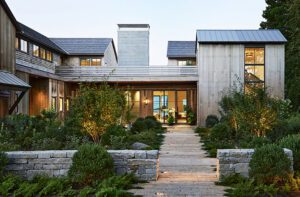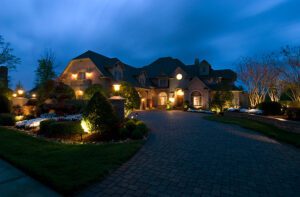A Contemporary Home with an Agrarian Edge
July 23, 2021
A geological challenge inspires a Fairfield County home to find its true nature.
Text by Debra Judge Silber Photography by Michael J. Lee
Lots of houses are built from the ground up. Fewer are built from the ground itself.
In the case of this Fairfield County home, the rock ledge resting just below the earth’s surface would become more than an obstruction to be removed. It would become a natural choice to adorn the new home’s gables, chimneys, fireplaces, and garden walls.
It’s an apt adaptation in a region so rugged that Colonial settlers routinely hiked around the area rather than pass through it, says Thomas McNeill, a principal with Hutker Architects.
“We had to deal with all of that stone,” he explains. “So we started making as much of the house out of the stone as we could. We sort of pulled the house up from the earth.”
There was a lot of stone there. “We excavated 5,000 cubic yards of rock,” says builder Paul Fontana, noting that the volume of the ledge effectively expands as it’s pulled from the ground. “When you blast rock, it fluffs up, like when you’re baking muffins,” he says. This isn’t the first house Fontana has built using native ledge. Nor is it for Tony Pelosi, his head stonecutter, whom Fontana describes as “the world’s last gray-haired Italian mason, right out of central casting.” It was Pelosi, along with three assistants, who created the home’s veneers that read as solid walls and its hand-built fireboxes with herringbone linings.
“Many masons aren’t up to the task of doing this,” says Fontana, “this” meaning chipping boulders the size of golf carts into usable blocks. “They don’t get shot out of the ground at a nice six-inch thickness,” he points out.
It’s very much a handmade house, with an agrarian edge that sets it apart from the more formal estates in the area. Its roof shingles and siding are Alaskan yellow pine, softening to gray at the edges. The walls inside the entry are clad with raw steel with a swirling milled finish. Ragged wooden beams salvaged from Pennsylvania barns, their hand-cut mortises visible, span plaster ceilings. Reclaimed wood of a later vintage was used to build a section of the kitchen island, along with a pair of tables and a bench in the breakfast nook. All three were crafted by master carpenter John Sweeny from a tree that once stood in the yard of some friends of the homeowners.
The house itself is an assemblage: four distinct but conjoined structures contain a garage, a guest/office wing, and, in the two largest sections, family spaces that include a primary bedroom suite, a homework space, and smaller suites for four resident teenagers. A pantry, mudroom, kitchen, and living and dining areas occupy the main floors. A courtyard in front serves as an extension of the living room and a buffer to the street. In the back, a sheltered patio with a pizza oven and wood-fired grill is poised for poolside entertaining.
A few yards away, a hunk of ledge breaks the surface of the lawn. Left in place, says McNeill, as a tribute to all that remains beneath.
Project Team
Architecture and interior design: Mark Hutker, Thomas McNeill, Ryan Alcaidinho, Hutker Architects
Builder: Paul Fontana, Cum Laude Group
Landscape design: Gregory Lombardi, Gregory Lombardi Design
Share
![NEH-Logo_Black[1] NEH-Logo_Black[1]](https://b2915716.smushcdn.com/2915716/wp-content/uploads/2022/08/NEH-Logo_Black1-300x162.jpg?lossy=1&strip=1&webp=1)




















You must be logged in to post a comment.